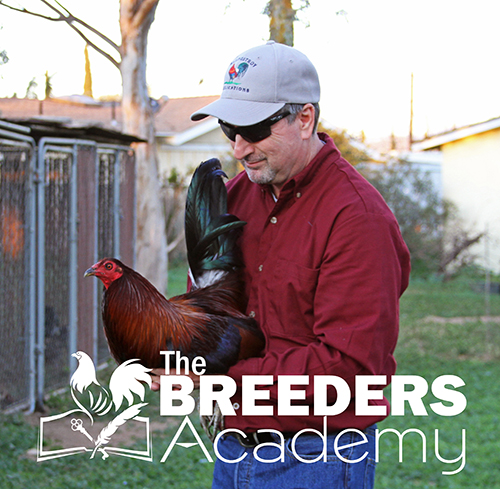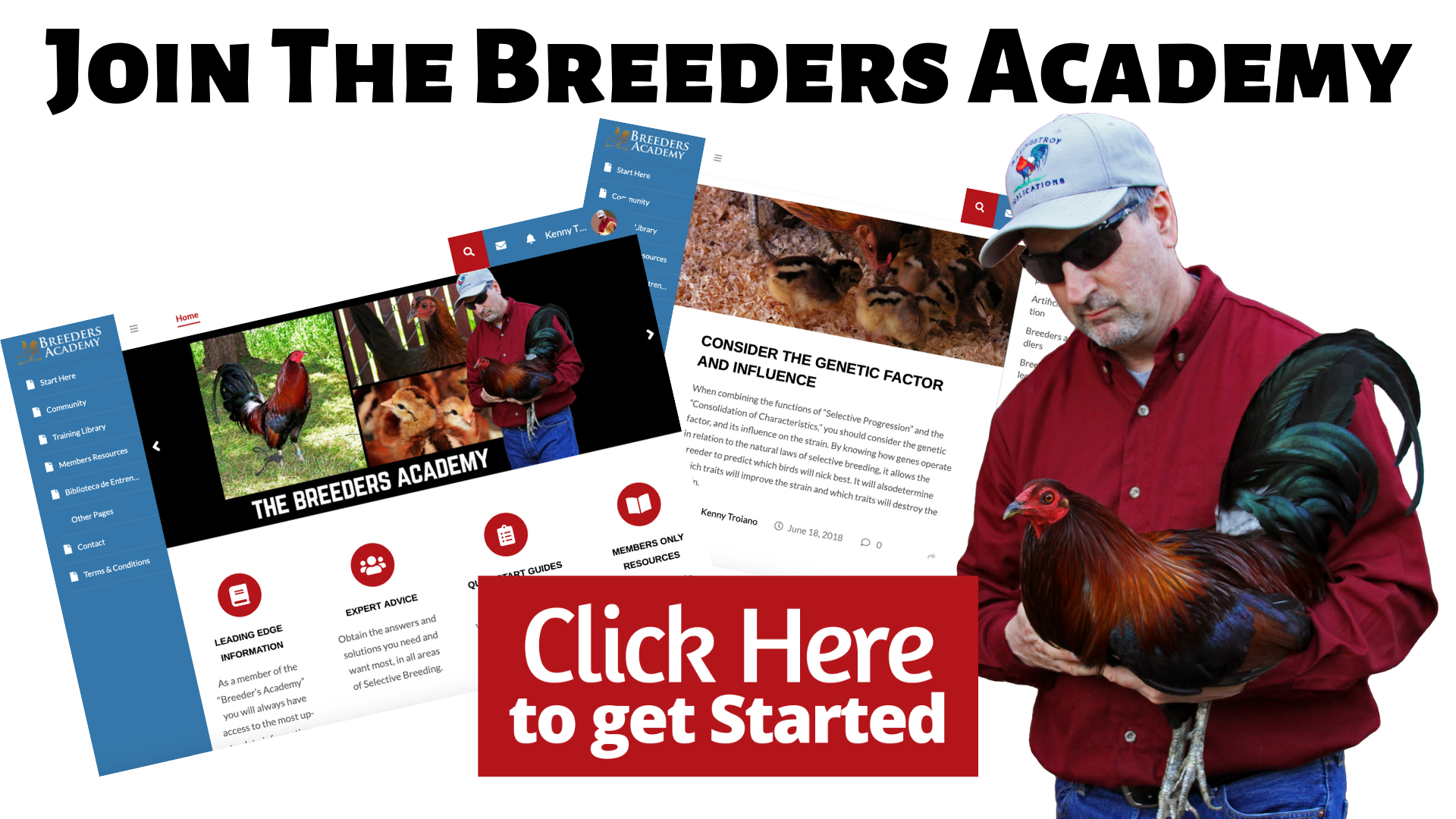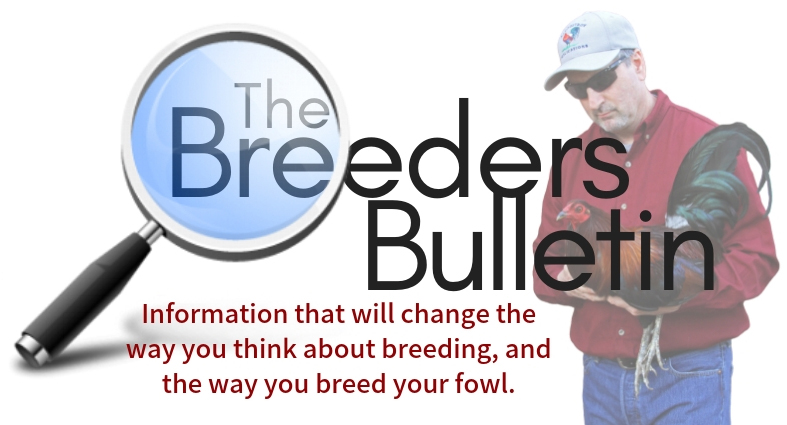
In this lesson, I will show you how I learned these 3 very important laws.
- Selective Breeding and Systematic Breeding Programs
- Evolutionary Biology
- And Genetic Inheritance
As you will see, there is more to breeding than just putting two birds together. And, there’s more to breeding than just breeding “Best to the Best.” That’s why I created the Breeder’s Academy, to show new and established breeders a different way of breeding.
Like Math, there are many ways to solve a mathematical problem, just like there are many ways to breed chickens. But, in the Breeders Academy I show them how to put many different methods of breeding together and how and when to apply each method.
Once I learned these laws, I was able to take me, as a breeder, and my fowl to the next level.
So, how did I discover these laws? In the beginning, I was like most breeders. I bred my best birds. Many like to think of this as “breeding the best to the best.” The problem was, I thought I knew what the best was. But, when I looked at old pictures of my birds from that time period, I realized, that way of thinking and breeding was so wrong.
- First of all, I didn’t understand the proper conformation of body and color of plumage.
- Secondly, I didn’t realize the importance of type or temperament.
- And thirdly, I didn’t realize the consequences of defects and poor health.
If so many breeders believe in breeding best to best, what’s wrong with that thought process? I was breeding what I thought was the best to the best, but in many cases, the birds I was breeding were extremely flawed. And those flaws were passed down to their offspring with a vengeance. Each generation was a bigger disappointment than the last. And I almost lost hope.
When did I start seeing improvement? I made some progress once I started selecting better and culling harder. In fact, learning what to cull and when to cull made a ton of difference. As I started to selectively breed, with purpose, they began to look like true American Games, but the problem was, they still didn’t look like a family.
Like many, I was crossing and infusing new blood all the time. I thought I was adding traits that my birds did not have, or adding traits that would hopefully improve mine. This only made things worse. Why was crossing and infusing new blood making my breeding lines worse? All I was doing was adding more defects and traits that was taking my fowl in the wrong direction. Their conformation of body and color varied from one extreme to the other, and they did not look or represent their breed.
This is where having the right mentors is so important. Because, when you are going in the wrong direction, and unaware of it, your mentor can see what the problem is, and correct you before you spend years of breeding and wasting time and money.
In my case, my mentor suggested that I learn how to mate and match my birds properly by not crossing to other breeds (such as Aseel) or other strains (such as hatch to sweater), or to different color groups (such as duckwing to crow-wings, or to self-colors).
Did listening to my mentor’s suggestion make a difference? That suggestion really took me to the next level. However, each breeding season was still sporadic and unpredictable, and they didn’t have the uniformity and consistency I was looking for. In short, they didn’t look like a family yet.
Another mentor said, I’m doing a lot of things right, but I’m missing some key elements that are holding me and my fowl back. He said, I need to start using systematic breeding programs. I know this sounds complicated, and it did for me too. But, it’s actually very simple. And that is what we are going to talk about in this lesson!
Most breeders use breeding methods, such as inbreeding, line-breeding, outcrossing, or some sort of rotational system. As well as many other methods, which are all very common breeding methods. But they are using them wrong, or using them at the wrong time, or too much. They need to realize that these are just methods, not a complete breeding program. Also, when they are properly applied, this can mean the difference between a successful breeding season and a failed one.
A breeding program uses these methods, and others, for a specific purpose, in a specific order, or at the right time, and for a specific length of time.
How many breeding programs are there? I learned that there are around 4 main breeding programs that are used by the most successful breeders. One is for creating a strain, another’s are used for improving and maintaining a strain. These are breeding programs that most don’t know about, and are not shared with others. I teach these programs at the Breeders Academy, and have special names for them. For example – I call these programs:
- The Founders Program
- The Transformation Program
- The Improvement Program
- And the Preservation Program
Each of these breeding programs have a special junction and purpose.
And by sharing these programs, I have made some enemies. I’ve let the secret out. Many breeders were upset with me for sharing these breeding programs. But I have always believed that if we are going to preserve or improve our breeds, all breeders need to learn how to breed properly. Finding out about these programs was like finding a pot of gold, especially when I saw how well they worked. I was seeing results like never before. And I soon got the respect from other breeders. My fowl suddenly became highly sought after. Needless to say, I was on top of the world.
My fowl began to show uniformity. Each one looked like the other, but I wasn’t quite done yet. I was still missing something. I was not able to predict my matings or determine the direction of my strain. The strain was improving, but not in the direction I wanted or needed them to go. That was when I learned the value of applying evolutionary biology and genetics to my breeding programs.
Once I found out how important it was to have the knowledge of Selective Breeding and Systematic Breeding Programs, and have a good understanding of Evolutionary Biology, and Genetics, I realized I can now sculpt and mold my birds into the family and strain I wanted. For example: I can tweak and change them. I can improve traits and eliminate defects, and I can create a family that is healthy and resistant to disease, instead of using medications and vaccinations. I became more successful because I understood genetics and evolutionary biology, and had a better understanding of when and how to apply specific breeding methods. In short, this put the power of selection in my hands, and not on luck or chance.
Not only are my fowl going in the right direction, but I have less defects, fewer culls and less sick chickens. The percentage of good birds are higher, and I have more standouts as well. It’s the standouts that have the power to take your strain to the next level. Without the standouts, you are going backwards.
I didn’t start seeing results in the right direction until I studied, what I like to call, the 3 laws of selective breeding. In fact, that’s why I call this lesson the “3 Laws of Breeding,” and it consist of:
- Selective Breeding and Systematic Breeding Programs
- Evolutionary Biology
- And Genetics
Are these Principles and Practices of Mating and Breeding something everyone should learn? I do believe, if you are a breeder, and want to create a new strain, or improve your established strain, this is what you need to learn to move forward. You can learn this on your own, but we do offer these programs and courses inside the Breeders Academy. So, make sure to take advantage of these.
How do you get Started? You can start by learning:
- The laws of selective breeding. How to properly select and cull your strain. Selection to advance your strain, and culling to preserve your strain.
- The proper type, conformation of body, and color or plumage, of your breed and variety.
- How to improve traits, such as, temperament, performance and production qualities of your strain.
- How to improve health and vigor.
- And understand the benefits of a standard – your strain must represent their breed.
Secondly, by learning and using “systematic breeding programs.” This consist of:
- the proper Methods of Mating
- the proper Methods of Breeding
- and using the right Breeding Program
And Thirdly, by learning Evolutionary Biology and the Laws of Inheritance. So, why was it so important to understand Evolutionary Biology? You learn that things change due to selection points and their environment, be it natural or artificial. And that you, the breeder, can use this to your advantage to determine the direction of that change. This gives the breeder the power to sculpt and mold his strain into anything he wants.
What are the tools of inheritance that breeders use?
- Purity of blood – which consist of:
- Ancestry
- Atavistic Expression (or throwbacks)
- Uniformity and Consistency
- The Reduction of Potential Variation
- Genetics – basic genetics (Mendelism) and more advanced genetics (Morgans).
- Monogenic traits, dominant or recessive traits. Also known as Qualitative inheritance (existent or non-existent).
- Polygenic traits, multiple gene traits, that are measurable (bell-shaped curve) and shows variation of intensities. Also known as Quantitative Inheritance.
- Sex-linked traits, genes carried on the sex-chromosome.
These tools of breeding allow us to predict our results, evaluate the parents through progeny testing, and determine their effects on future offspring.
Conclusion: It’s one thing to know what you want, but it’s another thing entirely to know how to get it. This is true with breeding as well. Some traits are easier to produce than others, and some traits block the expression of other traits. Knowing which birds to mate – to produce a particular result is due to the knowledge and skills of the breeder.
When you understand the “how’s and why’s” of genetics, you will know with great accuracy the results of every mating. Knowing genetics allows you, the breeder, to perform test matings that will educate you of the strain’s genetic make-up, and to know which traits are hidden and which traits are pure (homozygous or heterozygous). It wasn’t until I understood how these laws work, and how they relate to each other, that I was able to create a successful strain. Once I realized that the function as one, everything about breeding started to make sense. It was like a light bulb turned on.
Join the Breeders Academy and get the complete package of Show Notes, Pictures, and Bonus Materials related to this topic.
You can also learn more about our breeding program, called the “Founders Program,” in the Breeders Academy.

